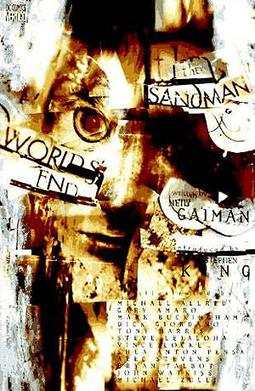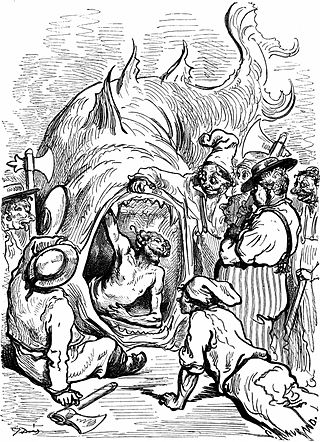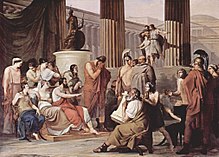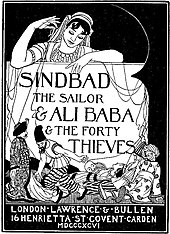
The Canterbury Tales is a collection of twenty-four stories that runs to over 17,000 lines written in Middle English by Geoffrey Chaucer between 1387 and 1400. It is widely regarded as Chaucer's magnum opus. The tales are presented as part of a story-telling contest by a group of pilgrims as they travel together from London to Canterbury to visit the shrine of Saint Thomas Becket at Canterbury Cathedral. The prize for this contest is a free meal at the Tabard Inn at Southwark on their return.

One Thousand and One Nights is a collection of Middle Eastern folktales compiled in the Arabic language during the Islamic Golden Age. It is often known in English as the Arabian Nights, from the first English-language edition, which rendered the title as The Arabian Nights' Entertainment.
A first-person narrative is a mode of storytelling in which a storyteller recounts events from that storyteller's own personal point of view, using first-person grammar such as "I", "me", "my", and "myself". It must be narrated by a first-person character, such as a protagonist, re-teller, witness, or peripheral character. Alternatively, in a visual storytelling medium, the first-person perspective is a graphical perspective rendered through a character's visual field, so the camera is "seeing" out of a character's eyes.

Worlds' End (1994) is the eighth collection of issues in the DC Comics series The Sandman. It was written by Neil Gaiman; illustrated by Michael Allred, Gary Amaro, Mark Buckingham, Dick Giordano, Tony Harris, Steve Leialoha, Vince Locke, Shea Anton Pensa, Alec Stevens, Bryan Talbot, John Watkiss, and Michael Zulli; colored by Danny Vozzo; and lettered by Todd Klein. The stories in the collection first appeared in 1993. The collection first appeared in paperback and hardback editions in 1994 with an introduction by Stephen King. The collection's title, setting, and a number of its themes and images are also found in G.K. Chesterton's poem "A Child of the Snows".

A story within a story, also referred to as an embedded narrative, is a literary device in which a character within a story becomes the narrator of a second story. Multiple layers of stories within stories are sometimes called nested stories. A play may have a brief play within it, such as in Shakespeare's play Hamlet; a film may show the characters watching a short film; or a novel may contain a short story within the novel. A story within a story can be used in all types of narration including poems, and songs.

A narrative, story, or tale is any account of a series of related events or experiences, whether nonfictional or fictional. Narratives can be presented through a sequence of written or spoken words, through still or moving images, or through any combination of these. The word derives from the Latin verb narrare, which is derived from the adjective gnarus. The formal and literary process of constructing a narrative—narration—is one of the four traditional rhetorical modes of discourse, along with argumentation, description, and exposition. This is a somewhat distinct usage from narration in the narrower sense of a commentary used to convey a story. Many additional narrative techniques, particularly literary ones, are used to build and enhance any given story.

Sinbad the Sailor is a fictional mariner and the hero of a story-cycle. He is described as hailing from Baghdad during the early Abbasid Caliphate. In the course of seven voyages throughout the seas east of Africa and south of Asia, he has fantastic adventures in magical realms, encountering monsters and witnessing supernatural phenomena.
Diegesis is a style of fiction storytelling which presents an interior view of a world in which the narrator presents the actions of the characters to the readers or audience.

An unreliable narrator is a narrator whose credibility is compromised. They can be found in fiction and film, and range from children to mature characters. The term was coined in 1961 by Wayne C. Booth in The Rhetoric of Fiction. While unreliable narrators are almost by definition first-person narrators, arguments have been made for the existence of unreliable second- and third-person narrators, especially within the context of film and television, and sometimes also in literature.
Narrative poetry is a form of poetry that tells a story, often using the voices of both a narrator and characters; the entire story is usually written in metered verse. Narrative poems do not need to rhyme. The poems that make up this genre may be short or long, and the story it relates to may be complex. It is normally dramatic, with various characters. Narrative poems include all epic poetry, and the various types of "lay", most ballads, and some idylls, as well as many poems not falling into a distinct type.
Narration is the use of a written or spoken commentary to convey a story to an audience. Narration is conveyed by a narrator: a specific person, or unspecified literary voice, developed by the creator of the story to deliver information to the audience, particularly about the plot: the series of events. Narration is a required element of all written stories, presenting the story in its entirety. It is optional in most other storytelling formats, such as films, plays, television shows and video games, in which the story can be conveyed through other means, like dialogue between characters or visual action.

"The Pardoner's Tale" is one of The Canterbury Tales by Geoffrey Chaucer. In the order of the Tales, it comes after The Physician's Tale and before The Shipman's Tale; it is prompted by the Host's desire to hear something positive after the physician's depressing tale. The Pardoner initiates his Prologue—briefly accounting his methods of swindling people—and then proceeds to tell a moral tale.
A plot twist is a literary technique that introduces a radical change in the direction or expected outcome of the plot in a work of fiction. When it happens near the end of a story, it is known as a twist or surprise ending. It may change the audience's perception of the preceding events, or introduce a new conflict that places it in a different context. A plot twist may be foreshadowed, to prepare the audience to accept it, but it usually comes with some element of surprise. There are various methods used to execute a plot twist, such as withholding information from the audience, or misleading them with ambiguous or false information. Not every plot has a twist, but some have multiple lesser ones, and some are defined by a single major twist.

"The Man of Law's Tale" is the fifth of the Canterbury Tales by Geoffrey Chaucer, written around 1387. John Gower's "Tale of Constance" in Confessio Amantis tells the same story and may have been a source for Chaucer. Nicholas Trivet's Les chronicles was a source for both authors.

The General Prologue is the first part of The Canterbury Tales by Geoffrey Chaucer. It introduces the frame story, in which a group of pilgrims travelling to the shrine of Thomas Becket in Canterbury agree to take part in a storytelling competition, and describes the pilgrims themselves. The Prologue is arguably the most familiar section of The Canterbury Tales, depicting traffic between places, languages and cultures as well as introducing and describing the pilgrims who will narrate the tales.
A flashback is an interjected scene that takes the narrative back in time from the current point in the story. Flashbacks are often used to recount events that happened before the story's primary sequence of events to fill in crucial backstory. In the opposite direction, a flashforward reveals events that will occur in the future. Both flashback and flashforward are used to cohere a story, develop a character, or add structure to the narrative. In literature, internal analepsis is a flashback to an earlier point in the narrative; external analepsis is a flashback to a time before the narrative started.

The Morall Fabillis of Esope the Phrygian is a work of Northern Renaissance literature composed in Middle Scots by the fifteenth century Scottish makar, Robert Henryson. It is a cycle of thirteen connected narrative poems based on fables from the European tradition. The drama of the cycle exploits a set of complex moral dilemmas through the figure of animals representing a full range of human psychology. As the work progresses, the stories and situations become increasingly dark.

The Decameron, subtitled Prince Galehaut and sometimes nicknamed l'Umana commedia, is a collection of short stories by the 14th-century Italian author Giovanni Boccaccio (1313–1375). The book is structured as a frame story containing 100 tales told by a group of seven young women and three young men; they shelter in a secluded villa just outside Florence in order to escape the Black Death, which was afflicting the city. Boccaccio probably conceived of the Decameron after the epidemic of 1348, and completed it by 1353. The various tales of love in The Decameron range from the erotic to the tragic. Tales of wit, practical jokes, and life lessons contribute to the mosaic. In addition to its literary value and widespread influence, it provides a document of life at the time. Written in the vernacular of the Florentine language, it is considered a masterpiece of early Italian prose.
J. R. R. Tolkien used frame stories throughout his Middle-earth writings, especially his legendarium, to make the works resemble a genuine mythology written and edited by many hands over a long period of time. He described in detail how his fictional characters wrote their books and transmitted them to others, and showed how later in-universe editors annotated the material.














